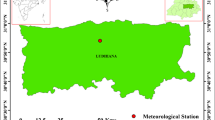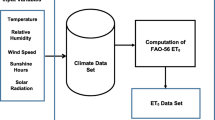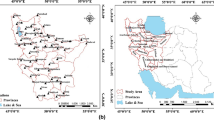Abstract
This study has been undertaken to estimate the change in climatic parameters of Kurukshetra region, viz. annual average minimum and maximum air temperatures, annual morning and evening relative humidity, sunshine hours, wind speed, and rainfall, from 2000 to 2013 and hence its influence on reference evapotranspiration (ET0) as obtained by Penman–Monteith method. An Excel-embedded software MAKESENS (Mann–Kendall test for trend and Sen’s slope estimates) has been used for observing and estimating trends in the time series of reference evapotranspiration and climatic parameters. Sen’s slope analysis indicates that average annual maximum air temperature, wind velocity, and reference evapotranspiration show increasing trends with 0.08%, 0.12%, and 3.28% slopes, respectively, whereas decreasing trend is observed in average rainfall, relative humidity (morning), and sunshine hours with −12.0, −0.08, and −0.04%, slopes. The trends of minimum air temperature and relative humidity (evening) show no change. The positive trend in reference crop evapotranspiration indicates that the water demand required for different crops in various seasons will increase. This will warrant developing less water-intensive crops as water availability is already under stress.
Access provided by CONRICYT-eBooks. Download conference paper PDF
Similar content being viewed by others
Keywords
1 Introduction
Haryana is a major agriculture state in northwestern India. A large part of Haryana is located on the Indo-Gangetic alluvial plain. Irrigation in the state is mainly facilitated by canal networks originating from rivers of Punjab and Uttarakhand states and also local groundwater. Two of the most common crops in the state are rice in Kharif season and wheat in Ravi season. The crop yield is mainly influenced by the adequate and timely availability of water. However, the last century (1906–2005) has witnessed a significant positive change in the earth temperature (0.74 °C) caused by large-scale emission of greenhouse gases which is largely attributed to the anthropogenic activities and that has provoked the change in climate [1]. The adverse effect of climate change is on agriculture productivity because of decrease in rainfall and increase in temperature. Demand of irrigation water is closely related to climate change as increased dryness leads to increase demand (IPCC 2001). Evapotranspiration is a necessary parameter in irrigation system design [2]. In the past decades, various researchers have examined the possible impact of climate change on reference evapotranspiration (ET0). According to these studies, results show that the trends in ET0 vary with climatic conditions and region [3]. A study has been conducted to assess the sensitivity of evapotranspiration in respect of global warming in the arid zone of Rajasthan, India [4]. The study suggested an increase of 14.8% of total ET0 demand to increase in temperature by 20%. The study also concluded that the sensitivity of ET0 is less with increase in net solar radiation, followed by wind speed as compared to temperature. An increase of 10% of temperature, along with a 10% decrease in net solar radiation and wind speed, could be a marginal decrease in total ET (0.36%). Further, spatiotemporal characteristics of potential evapotranspiration (PET) trends are studied in China using time series from 65 stations and found a decreasing trend at all stations [5]. Furthermore, the study of Ojeda-Bustamante [6] found that by the end of century, the annual increase in reference evapotranspiration will be 10% higher compared to current value due to climate change under moderate–medium emission scenario. The present paper investigates the influence on reference evapotranspiration (ET0) due to change in climatic factors as a result of climate change in Kurukshetra district of Haryana state.
2 Study Area and Methodology
2.1 Climatic Characteristics of Kurukshetra
The study site is located in the rice—wheat production zone of Haryana state. It lies between 29°11′–30°16′N latitude and 76°11′–77°17′W longitude, which is about 240 m above mean sea level. The location map of the area is shown in Fig. 1. The climatic conditions of the state are classified as semiarid tropical to subtropical. Annual rainfall of state ranges from less than 300 mm to over 1000 mm (mean 704 mm). About 75–80% of the rain falls during June September. Major crop cultivated in this area includes rice, maize, wheat, mustard, and fodder crops.
2.2 Collection of Meteorological Data
Daily meteorological data have been collected from ICAR meteorological center, Karnal, Haryana. Daily data constitute maximum temperature, minimum temperature, morning and evening relative humidity, wind speed and sunshine hours from the year 2000 to 2013. The data set is used for trend analysis using Mann Kendall test.
2.3 Mann–Kendall Test
The Mann–Kendall test used for identifying the trends variation in climatic variables and ET0 from time series data is one of the widely accepted nonparametric tests [7,8,9]. Hence, in this study, M–K test has been used to study the trends of climatic variables and ET0. Detailed information related to the Mann–Kendall test can be found in studies published by Hamed [7,8,9].
2.4 Sen’s Slope Estimator
The existing trend (change/year) slope can be identified using the Sen’s nonparametric method. If it is assumed that the case under study has a liner trend then, \(\textit{F}(t)\), is defined as:
where Q represents the trend slope and B is a constant value.
The slope Q (Eq. 1) can be estimated only after the calculation of all paired data values slopes. The slope of all data pairs can be estimated as:
If the number of values of \(x_{j}\) in a time series is n, then the slope estimates of \(Q_{j}\) are \(N = {{n(n - 1)} \mathord{\left/ {\vphantom {{n(n - 1)} 2}} \right. \kern-0pt} 2}\). The median of the slope estimates \(\left( N \right)\) represents the Sen’s estimator of slope for \(Q_{j}\). The N values of \(Q_{j}\) are arranged in ascending order, and the Sen’s estimator is defined as:
If the slope estimate N is odd, then
If the slope estimate N is even, then
A normal distribution-based nonparametric method is used to calculate a 100 (1 − α) % two-sided confidence interval. The applicability of the method is limited up to a minimum value of n which is 10, unless there are many ties.
The calculations for meteorological variables and ET0 values using Mann–Kendall tests and Sen’s slope estimator were performed using MAKESENS 1.0 which is an Excel-based software.
2.5 Penman–Monteith Equation
The Penman–Monteith equation is given by the United Nations Food and Agriculture Organization (FAO) for modeling evapotranspiration. Recently, a study conducted by Ngongondo et al. suggested that the Penman–Monteith method is most suited for modeling the evapotranspiration phenomenon (Ngongondo et al. in press). The definition of Penman–Monteith method for the estimation of daily reference crop is given as [10]:
where \(ET_{0}\) is climatic parameter representing the reference crop evapotranspiration [mm day−1], G is the soil heat flux density [MJ m−2 day−1], \(U_{2}\) is the wind speed at 2 m height [m s−1], \(R_{n}\) is denotes the net radiation at the crop surface [MJ m−2 day−1], T represents the mean daily air temperature at 2 m height [°C], \(e_{s}\) and \(e_{a}\) are the saturation and actual vapor pressure [kPa], \(e_{s} - e_{a}\) is the saturation vapor pressure deficit [kPa], \(\Delta\) shows the curve of slope vapor pressure [kPa °C−1] and \(\gamma\) psychometric constant [kPa °C−1]. \(ET_{0}\) has two components: the radiative component \(ET_{0R}\) and the aerodynamic component \(ET_{0a}\), expressed as the first and second parts. \(ET_{0}\) represents the evapotranspiration from standardized vegetated surface and is a combination of two terms that include energy term and aerodynamic (wind and humidity) term, respectively. The definition of \(ET_{0}\), \(ET_{0R}\), and \(ET_{0a}\) is given as:
\(ET_{0R}\) represents the reference evapotranspiration that would be obtained if the heat budget of surface were determined by radiation alone. \(ET_{0a}\) is the reference evapotranspiration imposed by the environment when the surface is fully coupled with the prevailing weather.
3 Estimation of Crop Evapotranspiration
The crop-specific evapotranspiration rate is obtained by multiplying by proper crop coefficient \(\left( {K_{c} } \right)\) to the calculated reference evapotranspiration which ultimately gives the actual crop evapotranspiration \(\left( {ET_{C} } \right)\).
where \(ET_{0}\) represents the reference crop evapotranspiration, \(K_{c}\) is the crop coefficient, and \(ET_{C}\) is the crop evapotranspiration.
Due to different growth patterns of the same crop, different evapotranspiration demand is obtained. Crop water demand is directly related to the crop planting time or season as the evapotranspiration varies in every season due to differential energy pattern. Further, the plant factors like leaf area (evaporative surface) and stomatal closure behavior also influence evapotranspiration.
4 Results and Discussion
4.1 Study of Climate Parameter
Trend variations of different climatic parameters, viz., temperatures (maximum, average, and minimum), relative humidity (morning, average, and evening), wind velocity, sunshine hours, and rainfall, over the period of 14 years, 2000–2013, at Kurukshetra are presented in Figs. 2, 3, and 4, respectively, using MAKESENS. Figure 5 shows trend variation in reference evapotranspiration as obtained from Eq. (4).
In Fig. 2, it is seen that overall positive trend has been found with the rate of increase in maximum temperature as 0.08%. The graph also shows variation in trend with confidence interval of 99 and 95%. The residual value of maximum temperature is maximum in the year 2009 as compared to normal annual maximum temperature as shown in Fig. 6. Variation in average temperature and minimum temperature shows that there is no change in trend over the 14 years. There is rise and fall every four years. Variation in trend with confidence interval of 99 and 95% has also been plotted. The positive trend in maximum temperature indicates rise in temperature with time.
From Fig. 3, it is observed that overall negative trend has been found with the rate of decrease in relative humidity (morning) as −0.08%. The graph also shows variation in trend with confidence interval of 99 and 95%. The residual value is more or less negligible as shown in Fig. 6. Variation in relative humidity (evening) and relative humidity (average) shows that there is no change in trend over the 14 years. Variation in trend with confidence interval of 99 and 95% is also negligible.
Figure 4 corresponds to trend variations in sunshine hours, wind velocity, and rainfall from 2000 to 2013, and it is seen that there are negative, positive, and negative trends, respectively, with slope values as −0.04%, +0.12%, and −12.00%. There was also significant change in rainfall from 691 to 479 mm and 479 to 288 mm during 2004–2005 and 2005–2006, respectively. Negative trend in rainfall shows that rainfall magnitude is decreasing with time.
Using the above climatic parameters, the reference evapotranspiration was obtained using Eq. (4) and plotted in Fig. 5. During the interval from 2002 to 2006, \(ET_{0}\) was below the normal value except in 2002 and 2004, but it was found above the normal value during 2008–2012, and it was above the normal value in last 5 years. It is found that the trend is positive and its slope is increasing by 3.28%.
There were major dips for \(ET_{0}\) in years 2005 and 2007 with the values of 1328 mm and 1330 mm, respectively. As we go toward the proceeding years, from 2007 up to 2009, \(ET_{0}\) was found continuously increasing from 1330 mm to 1385 mm as wind velocity increases from 3.6 to 4.4 km/h and maximum temperature increases from 31.2 °C to 32.8 °C. During the period 2010–2013, it is observed that there are significant drops in seasonal ET0 and maximum temperature i.e. from 1372 mm to 1348 mm and 31.3 °C to 28.7 °C, respectively. However, in the same period, there are increases in average relative humidity and wind velocity with their values increasing from 60.0 to 62.4% and 4.3 km/h to 4.7 km/h, respectively. This reflects that water demand of crop is increasing with every year. The negative rainfall trend and positive reference evapotranspiration warrant developing less water-intensive crops as water availability is already under stress.
5 Conclusions
The following conclusions are drawn from the analysis of data of climatic parameters from 2000 to 2013:
-
1.
Maximum temperature and wind velocity show positive trends with the rate of increment of about 0.08% and 0.12%, respectively, while negative trend is observed in relative humidity (morning), sunshine hours, and rainfall with rate of reduction as −0.08, −0.04, and −12.00%.
-
2.
Reference crop evapotranspiration shows positive trend with the rate increase as 3.28%. This reflects that water demand of crop is increasing with every year.
References
Sankaranarayanan, K., Praharaj, C.S., Nalayini, P., Bandyopadhyay, K.K., Gopalakrishnan, N.: Change and its impact on cotton (gossypium sp). Indian J Agric. Sci. 80(7), 561–75 (2010)
Zhang, X.Y., Chen, S.Y., Sun, H.Y., Shao, L.W., Wang, Y.Z.: Change in evapotranspiration over irrigated winter wheat and maize in north China Plain over three decades. Agric. Water Manag. 98(6), 1097–1104 (2011)
Rim, C.: The effect of urbanization geographical and topographical condition on reference evapotranspiration. Clim. Change 97(3–4), 483–514 (2009)
Goyal, R.K.: Sensitivity of evapotranspiration to global warming: a case study of arid zone of Rajasthan (India). Agric. Water Manag. 69(1), 1–11 (2004)
Thomas, A.: Spatial and temporal characteristics of potential evapotranspiration trends over China. Int. J. Climatol. 20, 381–396 (2000)
Ojeda-Bustamante, W., Sifuenten-lbarra, E., Iniguez-Covarrubias, M., Montero-Martinez, M.J.: Impact of Climate Change on crop development and water requirements. Mex. Agrocienc. 45(1) (2010). ISSN 1405-3195
Hamed, K.H.: Trend detection in hydrologic data: the Mann-Kendall trend test under the scaling hypothesis. J. Hydrol. 349(3–4), 350–363 (2008). doi:10.1016/j.jhydrol.2007.11.009
Liang, L.Q., Li, L.J., Liu, Q.: Temporal variation of reference evapotranspiration during 1961–2005 in the Taoer river basin of Northeast China. Agric. For. Meteorol. 150(2), 298–306 (2010). doi:10.1016/j.agrformet.2009.11.014
Liu, H.J., Li, Y., Tanny, J., Zhang, R.H., Huang, G.H.: Quantitative estimation of climate change effects on potential evapotranspiration in Beijing during 1951–2010. J. Geog. Sci. 24(1), 93–112 (2014). doi:10.1007/s11442-014-1075-5
Allen, R.G., Pereira, L.S., Raes, D., Smith, M.: Crop Evapotranspiration—Guidelines for Computing Crop Water Requirements—FAO Irrigation and Drainage Paper 56. Food and Agriculture Organization of United Nations (FAO), Rome (1998)
Author information
Authors and Affiliations
Corresponding author
Editor information
Editors and Affiliations
Rights and permissions
Copyright information
© 2017 Springer International Publishing AG
About this paper
Cite this paper
Soni, D.K., Singh, K.K. (2017). Trend Analysis of Climatic Parameters at Kurukshetra (Haryana), India and Its Influence on Reference Evapotranspiration. In: Garg, V., Singh, V., Raj, V. (eds) Development of Water Resources in India. Water Science and Technology Library, vol 75. Springer, Cham. https://doi.org/10.1007/978-3-319-55125-8_28
Download citation
DOI: https://doi.org/10.1007/978-3-319-55125-8_28
Published:
Publisher Name: Springer, Cham
Print ISBN: 978-3-319-55124-1
Online ISBN: 978-3-319-55125-8
eBook Packages: Earth and Environmental ScienceEarth and Environmental Science (R0)










